Estimation of Seasonal Evapotranspiration for Crops in Arid Regions Using Multisource Remote Sensing Images
Abstract
:1. Introduction
- (1)
- The SEBAL model is used to obtain ETd for crops in arid regions from Landsat images;
- (2)
- A trapezoidal method is employed to extend ETd to ETs using multitemporal ETd data; and,
- (3)
- A sinusoidal method is proposed to derive ETs from ETd using multisource remote sensing images.
2. Study Area and Data
2.1. Study Area
2.2. Study Data
3. Methods
3.1. ETd Estimation Based on the SEBAL Model
3.2. Validation of the SEBAL Algorithm Performance
3.3. ETs Estimation Based on the Trapezoidal Method
3.4. ETs Estimation Based on the Sinusoidal Method
4. Results
4.1. Temporal-Spatial Variation of ETinst and ETd Obtained by the SEBAL Model
4.2. Accuracy Assessment of ETd Obtained by the SEBAL Model
4.3. Validation Results of the Sinusoidal Method
4.4. Distribution of ET during Crop Growing Season
4.5. ET of Five Main Crops during the Growing Season
4.6. Performance of the Proposed Methods for Different Acquisition Frequency of Landsat Images
5. Discussion
6. Conclusions
- (1)
- The SEBAL model is effective in estimating the ETd of cotton using Landsat images in the agricultural lands of the Kai-Kong River Basin, Xinjiang, China.
- (2)
- Compared with the trapezoidal method, the sinusoidal method can obtain more accurate ETs when using Landsat images with low temporal resolution.
- (3)
- The sinusoidal method integrated with multisource remote sensing images offers a useful tool to estimate ETs with a spatial resolution of 30 m for crops in the arid area.
Author Contributions
Funding
Acknowledgments
Conflicts of Interest
References
- Duarte, R.; Yang, H. Input–Output and Water: Introduction to the Special Issue. Econ. Syst. Res. 2011, 23, 341–351. [Google Scholar] [CrossRef]
- Yu, O.; Raichle, B.; Sink, S. Impact of biochar on the water holding capacity of loamy sand soil. Int. J. Energy Environ. Eng. 2013, 4. [Google Scholar] [CrossRef] [Green Version]
- Rawat, K.S.; Singh, S.K.; Bala, A.; Szabó, S. Estimation of crop evapotranspiration through spatial distributed crop coefficient in a semi-arid environment. Agric. Water Manag. 2019, 213, 922–933. [Google Scholar] [CrossRef]
- Allen, R.G.; Pereira, L.S.; Raes, D.; Smith, M. Crop Evapotranspiration-Guidelines for Computing Crop Water Requirements-FAO Irrigation and Drainage Paper 56; FAO: Rome, Italy, 1998; Volume 300, p. D05109. [Google Scholar]
- Guo, E.W.; Zhang, L.J. Estimating Evapotranspiration Using SEBAL Model and Landsat-8 RS Data. J. Irrig. Drain. 2019, 38, 83–89. [Google Scholar]
- Wilson, K.B.; Hanson, P.J.; Mulholland, P.J.; Baldocchi, D.D.; Wullschleger, S.D. A comparison of methods for determining forest evapotranspiration and its components: Sap-flow, soil water budget, eddy covariance and catchment water balance. Agric. For. Meteorol. 2001, 106, 153–168. [Google Scholar] [CrossRef]
- Tyagi, N.; Sharma, D.; Luthra, S. Determination of evapotranspiration and crop coefficients of rice and sunflower with lysimeter. Agric. Water Manag. 2000, 45, 41–54. [Google Scholar] [CrossRef]
- Young, M.H.; Wierenga, P.J.; Mancino, C.F. LARGE WEIGHING LYSIMETERS FOR WATER USE AND DEEP PERCOLATION STUDIES. Soil Sci. 1996, 161, 491–501. [Google Scholar] [CrossRef]
- Dugas, W.; Fritschen, L.; Gay, L.; Held, A.; Matthias, A.; Reicosky, D.; Steduto, P.; Steiner, J. Bowen ratio, eddy correlation, and portable chamber measurements of sensible and latent heat flux over irrigated spring wheat. Agric. For. Meteorol. 1991, 56, 1–20. [Google Scholar] [CrossRef]
- Massman, W.J. A simple method for estimating frequency response corrections for eddy covariance systems. Agric. For. Meteorol. 2000, 104, 185–198. [Google Scholar] [CrossRef]
- Wagle, P.; Gowda, P.H.; Neel, J.P.; Northup, B.K.; Zhou, Y. Integrating eddy fluxes and remote sensing products in a rotational grazing native tallgrass prairie pasture. Sci. Total. Environ. 2020, 712. [Google Scholar] [CrossRef] [PubMed]
- Yinglan, A.; Wang, G.; Liu, T.; Xue, B.; Kuczera, G. Spatial variation of correlations between vertical soil water and evapotranspiration and their controlling factors in a semi-arid region. J. Hydrol. 2019, 574, 53–63. [Google Scholar] [CrossRef]
- Su, Z.; Yacob, A.; Wen, J.; Roerink, G.; He, Y.; Gao, B.; Boogaard, H.; Van Diepen, C. Assessing relative soil moisture with remote sensing data: Theory, experimental validation, and application to drought monitoring over the North China Plain. Phys. Chem. Earth, Parts A/B/C 2003, 28, 89–101. [Google Scholar] [CrossRef]
- Kang, S.Z.; Wang, P.X.; Ling, T. Comparative Analysis of Regional Evapotranspiration Estimation Models Using Remotely Sensed Data. Trans. Chin. Soc. Agric. Eng. 2006, 7, 6–13. [Google Scholar]
- Zhang, X.D.; Yang, X.G.; Li, H.Y. Model to Compute the Actual Evapo-Transpiration in the Field of Rainfed Wheat. Agric. Res. Arid Areas 2005, 1, 34–38. [Google Scholar]
- Wang, J.; Li, H.P.; Li, H.Y. Review of Regional Evapotranspiration Estimation Models Basing on the Remote Sensing. Water Sav. Irrig. 2016, 8, 195–199. [Google Scholar]
- Xu, X.; Zhang, L.; Chen, L.; Liu, C. The Role of Soil N2O Emissions in Agricultural Green Total Factor Productivity: An Empirical Study from China around 2006 when Agricultural Tax Was Abolished. Agriculture 2020, 10, 150. [Google Scholar] [CrossRef]
- Xu, X.; Chen, L. Projection of Long-Term Care Costs in China, 2020–2050, Based on the Bayesian Quantile Regression Method. Sustainability 2019, 11, 3530. [Google Scholar] [CrossRef] [Green Version]
- Xu, X.; Xu, Z.; Chen, L.; Li, C. How Does Industrial Waste Gas Emission Affect Health Care Expenditure in Different Regions of China: An Application of Bayesian Quantile Regression. Int. J. Environ. Res. Public Heal. 2019, 16, 2748. [Google Scholar] [CrossRef] [Green Version]
- Jahangir, M.H.; Arast, M. Remote Sensing Products for Predicting Actual Evapotranspiration and Water Stress Footprints under Different Land Cover. J. Clean. Prod. 2020, 266. [Google Scholar] [CrossRef]
- Xue, J.Y.; Bali, K.M.; Light, S. Evaluation of Remote Sensing-Based Evapotranspiration Models Against Surface Renewal in Almonds, Tomatoes and Maize. Agric. Water Manag. 2020, 238. [Google Scholar] [CrossRef]
- Jin, X.; Zhu, X.; Xue, Y. Satellite-based analysis of regional evapotranspiration trends in a semi-arid area. Int. J. Remote. Sens. 2019, 40, 3267–3288. [Google Scholar] [CrossRef]
- Zheng, C.; Jia, L.; Hu, G.; Lu, J. Earth Observations-Based Evapotranspiration in Northeastern Thailand. Remote. Sens. 2019, 11, 138. [Google Scholar] [CrossRef] [Green Version]
- Hu, G.; Jia, L. Monitoring of Evapotranspiration in a Semi-Arid Inland River Basin by Combining Microwave and Optical Remote Sensing Observations. Remote. Sens. 2015, 7, 3056–3087. [Google Scholar] [CrossRef] [Green Version]
- Zheng, C.; Jia, L.; Hu, G.; Menenti, M.; Lu, J.; Zhou, J.; Wang, K.; Li, Z. Assessment of Water Use in Pan-Eurasian and African Continents by ETMonitor with Multi-Source Satellite Data. In Proceedings of the International Symposium on Earth Observation for One Belt and One Road (EOBAR), Beijing, China, 16–17 May 2016; Volume 57. [Google Scholar] [CrossRef] [Green Version]
- Zhang, Y.; Hao, X.M.; Ding, H. A Simplified Mthod and Its Application for Estimating Potential Evapotranspiration. Arid Zone Res. 2019, 6, 1431–1439. [Google Scholar]
- Hu, G.; Jia, L.; Menenti, M. Comparison of MOD16 and LSA-SAF MSG evapotranspiration products over Europe for 2011. Remote. Sens. Environ. 2015, 156, 510–526. [Google Scholar] [CrossRef]
- Song, J.; Xu, C.C.; Yang, Y.Y. Temporal and Spatial Variation Characteristics of Evapotranspiration and Dry-Wet Climate in Xinjiang Based on MODIS16. Res. Soil Water Conserv. 2019, 5, 210–214. [Google Scholar]
- Ghilain, N.; De Roo, F.; Gellens-Meulenberghs, F. Evapotranspiration monitoring with Meteosat Second Generation satellites: Improvement opportunities from moderate spatial resolution satellites for vegetation. Int. J. Remote. Sens. 2014, 35, 2654–2670. [Google Scholar] [CrossRef]
- Ren, L.L.; Wei, L.Y.; Hu, J.S. Drought Monitoring Utility Assessment of CHIRPS and GLEAM Satellite Products in China. Trans. Chin. Soc. Agric. Eng. 2019, 15, 146–154. [Google Scholar]
- Yang, X.Q.; Wang, G.J.; Pan, X. Spatio-Temporal Variability of Terrestrial Evapotranspiration in China from 1980 to 2011 Based on GLEAM Data. Trans. Chin. Soc. Agric. Eng. 2015, 21, 132–141. [Google Scholar]
- Martens, B.; De Jeu, R.; Verhoest, N.E.C.; Schuurmans, H.; Kleijer, J.; MirallesiD, D.G. Towards Estimating Land Evaporation at Field Scales Using GLEAM. Remote. Sens. 2018, 10, 1720. [Google Scholar] [CrossRef] [Green Version]
- Martin, J.; Sujan, K.; Ulrich, W. The Fluxcom Ensemble of Global Land-Atmosphere Engery Fluxes. Scientific Data 2019, 6, 74–88. [Google Scholar]
- Courault, D.; Séguin, B.; Olioso, A. Review on estimation of evapotranspiration from remote sensing data: From empirical to numerical modeling approaches. Irrig. Drain. Syst. 2005, 19, 223–249. [Google Scholar] [CrossRef]
- Song, Y.; Wang, J.; Yang, K.; Ma, M.; Li, X.; Zhang, Z.; Wang, X. A revised surface resistance parameterisation for estimating latent heat flux from remotely sensed data. Int. J. Appl. Earth Obs. Geoinformation 2012, 17, 76–84. [Google Scholar] [CrossRef]
- Kool, D.; Agam, N.; Lazarovitch, N.; Heitman, J.; Sauer, T.; Ben-Gal, A. A review of approaches for evapotranspiration partitioning. Agric. For. Meteorol. 2014, 184, 56–70. [Google Scholar] [CrossRef]
- Su, Z. The Surface Energy Balance System (SEBS) for estimation of turbulent heat fluxes. Hydrol. Earth Syst. Sci. 2002, 6, 85–100. [Google Scholar] [CrossRef]
- Maniruzzaman, M.; Boateng, J.S.; Chowdhry, B.Z.; Snowden, M.; Douroumis, D. A review on the taste masking of bitter APIs: Hot-melt extrusion (HME) evaluation. Drug Dev. Ind. Pharm. 2013, 40, 145–156. [Google Scholar] [CrossRef]
- Bastiaanssen, W.G.M.; Menenti, M.; Feddes, R.A.; Holtslag, A.A.M. A Remote Sensing Surface Energy Balance Algorithm for Land (SEBAL) 1. Formulation. J. Hydrol. 1998, 212–213, 198–212. [Google Scholar] [CrossRef]
- Penman, H.L. Natural evaporation from open water, bare soil and grass. Proc. R. Soc. London. Ser. A Math. Phys. Sci. 1948, 193, 120–145. [Google Scholar] [CrossRef] [Green Version]
- Monteith, J.L. Evaporation and environment. Symp. Soc. Exp. Boil. 1965, 19, 205–234. [Google Scholar]
- Priestley, C.H.B.; Taylor, R.J. On the Assessment of Surface Heat Flux and Evaporation Using Large-Scale Parameters. Mon. Weather Rev. 1972, 100, 81–92. [Google Scholar] [CrossRef]
- Bastiaanssen, W.; Pelgrum, H.; Wang, J.; Ma, Y.; Moreno, J.; Roerink, G.; Van Der Wal, T. A remote sensing surface energy balance algorithm for land (SEBAL). J. Hydrol. 1998, 212, 213–229. [Google Scholar] [CrossRef]
- Rawat, K.S.; Bala, A.; Singh, S.K.; Pal, R.K. Quantification of wheat crop evapotranspiration and mapping: A case study from Bhiwani District of Haryana, India. Agric. Water Manag. 2017, 187, 200–209. [Google Scholar] [CrossRef] [Green Version]
- Bala, A.; Rawat, K.S.; Misra, A.K.; Srivastava, A. Assessment and Validation of Evapotranspiration using SEBALalgorithm and Lysimeter data of IARI Agricultural Farm, India. Geocarto Int. 2015, 31, 1–29. [Google Scholar] [CrossRef]
- Rahimzadegan, M.; Janani, A. Estimating evapotranspiration of pistachio crop based on SEBAL algorithm using Landsat 8 satellite imagery. Agric. Water Manag. 2019, 217, 383–390. [Google Scholar] [CrossRef]
- Bhattarai, N.; Quackenbush, L.; Im, J.; Shaw, S.B. A new optimized algorithm for automating endmember pixel selection in the SEBAL and METRIC models. Remote. Sens. Environ. 2017, 196, 178–192. [Google Scholar] [CrossRef]
- Ruhoff, A.L.; Paz, A.R.; Collischonn, W.; Aragão, L.E.; Rocha, H.R.; Malhi, Y. A MODIS-Based Energy Balance to Estimate Evapotranspiration for Clear-Sky Days in Brazilian Tropical Savannas. Remote. Sens. 2012, 4, 703–725. [Google Scholar] [CrossRef] [Green Version]
- Du, J.; Song, K.; Wang, Z.; Zhang, B.; Liu, D. Evapotranspiration estimation based on MODIS products and surface energy balance algorithms for land (SEBAL) model in Sanjiang Plain, Northeast China. Chin. Geogr. Sci. 2013, 23, 73–91. [Google Scholar] [CrossRef]
- Simaie, E.; Homaee, M.; Norouzi, A.A. Evaluating SEBAL Model to Estimate Evapotranspiration Using MODIS and TM Sensors Data. J. Soil Water Resour. Conserv. 2013, 2, 29–40. [Google Scholar]
- Singh, R.K.; Liu, S.; Tieszen, L.L.; Suyker, A.E.; Verma, S.B. Estimating seasonal evapotranspiration from temporal satellite images. Irrig. Sci. 2011, 30, 303–313. [Google Scholar] [CrossRef] [Green Version]
- Bhattarai, N.; Quackenbush, L.J.; Dougherty, M.; Marzen, L.J. A simple Landsat–MODIS fusion approach for monitoring seasonal evapotranspiration at 30 m spatial resolution. Int. J. Remote. Sens. 2014, 36, 115–143. [Google Scholar] [CrossRef]
- Wagle, P.; Bhattarai, N.; Gowda, P.H.; Zhou, Y. Performance of five surface energy balance models for estimating daily evapotranspiration in high biomass sorghum. ISPRS J. Photogramm. Remote. Sens. 2017, 128, 192–203. [Google Scholar] [CrossRef] [Green Version]
- Allen, R.G.; Tasumi, M.; Morse, A.; Trezza, R.; Wright, J.L.; Bastiaanssen, W.; Kramber, W.J.; Lorite, I.J.; Robison, C.W. Satellite-Based Energy Balance for Mapping Evapotranspiration with Internalized Calibration (METRIC)—Applications. J. Irrig. Drain. Eng. 2007, 133, 395–406. [Google Scholar] [CrossRef]
- Elnmer, A.; Khadr, M.; Kanae, S.; Tawfik, A. Mapping daily and seasonally evapotranspiration using remote sensing techniques over the Nile delta. Agric. Water Manag. 2019, 213, 682–692. [Google Scholar] [CrossRef]
- Zhang, P.; Long, A.H.; Hai, Y. The Spatiotemporal Variations and the Driving Forces of Agricultural Water Consumption in Xinjiang (1988-2015): Based on the Statistical Analysis of Crop Water Footprint. J. Glaciol. Geocryol. 2019. Available online: http://kns.cnki.net/kcms/detail/62.1072.P.20190918.1456.002.Html (accessed on 18 September 2019).
- Wang, W.H.; Huang, Y.; Liu, T. Optimized Redistribution of Water Resources in the Kaidu-Kongque River Basin. Arid Zone Res. 2018, 5, 1030–1039. [Google Scholar]
- Chen, Z.S.; Li, B.F.; Fu, A.H. Analysis of Water Demand and Stability for Oasis in Kaidu-Kongque River Basin, Southern Xinjiang. J. Glaciol. Geocryol. 2012, 6, 1470–1477. [Google Scholar]
- Krishnan, S.R.; Seelamantula, C.S. On the Selection of Optimum Savitzky-Golay Filters. IEEE Trans. Signal. Process. 2013, 61, 380–391. [Google Scholar] [CrossRef]
- Wang, X.-J. Participatory geographic information system review. Chin. J. Eco-Agric. 2010, 18, 1138–1144. [Google Scholar] [CrossRef]
- Cha, M.X.; Wang, X.Q.; Li, Y.L. Crop Planting Structure Extraction Based on Remote Sensing Data in Kai-Kong River Basin, Xinjiang. Arid Zone Res. 2020, 37, 532–540. [Google Scholar] [CrossRef]
- Yang, X.; Ren, L.; Jiao, D.; Yong, B.; Jiang, S.; Song, S. Estimation of Daily Actual Evapotranspiration from ETM+ and MODIS Data of the Headwaters of the West Liaohe Basin in the Semiarid Regions of China. J. Hydrol. Eng. 2013, 18, 1530–1538. [Google Scholar] [CrossRef]
- Allen, R.G.; Irmak, A.; Trezza, R.; Hendrickx, J.M.H.; Bastiaanssen, W.; Kjaersgaard, J. Satellite-based ET estimation in agriculture using SEBAL and METRIC. Hydrol. Process. 2011, 25, 4011–4027. [Google Scholar] [CrossRef]
- Gao, X.; Sun, M.; Luan, Q.; Zhao, X.; Wang, J.; He, G.; Zhao, Y.; Miao, S. The spatial and temporal evolution of the actual evapotranspiration based on the remote sensing method in the Loess Plateau. Sci. Total. Environ. 2020, 708. [Google Scholar] [CrossRef] [PubMed]
- Senkondo, W.; Munishi, S.E.; Tumbo, M.; Nobert, J.; Lyon, S.W. Comparing Remotely-Sensed Surface Energy Balance Evapotranspiration Estimates in Heterogeneous and Data-Limited Regions: A Case Study of Tanzania’s Kilombero Valley. Remote. Sens. 2019, 11, 1289. [Google Scholar] [CrossRef] [Green Version]
- Sun, H.; Yang, Y.; Wu, R.; Gui, D.; Xue, J.; Liu, Y.; Yan, D. Improving Estimation of Cropland Evapotranspiration by the Bayesian Model Averaging Method with Surface Energy Balance Models. Atmosphere 2019, 10, 188. [Google Scholar] [CrossRef] [Green Version]
- Jackson, R.; Hatfield, J.; Reginato, R.; Idso, S.; Pinter, P. Estimation of daily evapotranspiration from one time-of-day measurements. Agric. Water Manag. 1983, 7, 351–362. [Google Scholar] [CrossRef]
- Xie, X.Q. Estimation of Daily Evapo-Transpiration (ET) From One Time-of-Daily Remotely Sensed Canopy Temperature. J. Remote Sens. 1991, 4, 253–260. [Google Scholar]
- Vörösmarty, C.; Federer, C.; Schloss, A. Potential evaporation functions compared on US watersheds: Possible implications for global-scale water balance and terrestrial ecosystem modeling. J. Hydrol. 1998, 207, 147–169. [Google Scholar] [CrossRef]
- Grosso, C.; Manoli, G.; Martello, M.; Chemin, Y.; Pons, D.; Teatini, P.; Piccoli, I.; Morari, F. Mapping Maize Evapotranspiration at Field Scale Using SEBAL: A Comparison with the FAO Method and Soil-Plant Model Simulations. Remote. Sens. 2018, 10, 1452. [Google Scholar] [CrossRef] [Green Version]
- Lv, N.N.; Bai, J.; Chang, C. Spatial-Temporal Changes in Evapotranspiration Based on Planting Patterns of Major Crops in the Xinjiang Oasis During 1960–2010. Geograph. Res. 2017, 8, 1443–1454. [Google Scholar]
- Kamali, M.I.; Nazari, R. Determination of maize water requirement using remote sensing data and SEBAL algorithm. Agric. Water Manag. 2018, 209, 197–205. [Google Scholar] [CrossRef]
- Shen, Y.J.; Li, S.; Chen, Y.; Qi, Y.; Zhang, S. Estimation of regional irrigation water requirement and water supply risk in the arid region of Northwestern China 1989–2010. Agric. Water Manag. 2013, 128, 55–64. [Google Scholar] [CrossRef]
- Wang, M.; Yang, Q.; Zheng, J.H.; Liu, Z.H. Spatial and Temporal Distribution of Water Requirement of Cotton in Xinjiang from 1963 to 2012. Acta Ecologica Sinica 2016, 36, 4122–4130. [Google Scholar] [CrossRef]
- Jin, K.L.; Hao, L. Evapotranspiration Estimation in the Jiangsu-Zhejiang-Shanghai Area Baed on Remote Sensing Data and SEBAL Model. Remote Sens. Land. Res. 2020, 32, 204–212. [Google Scholar]

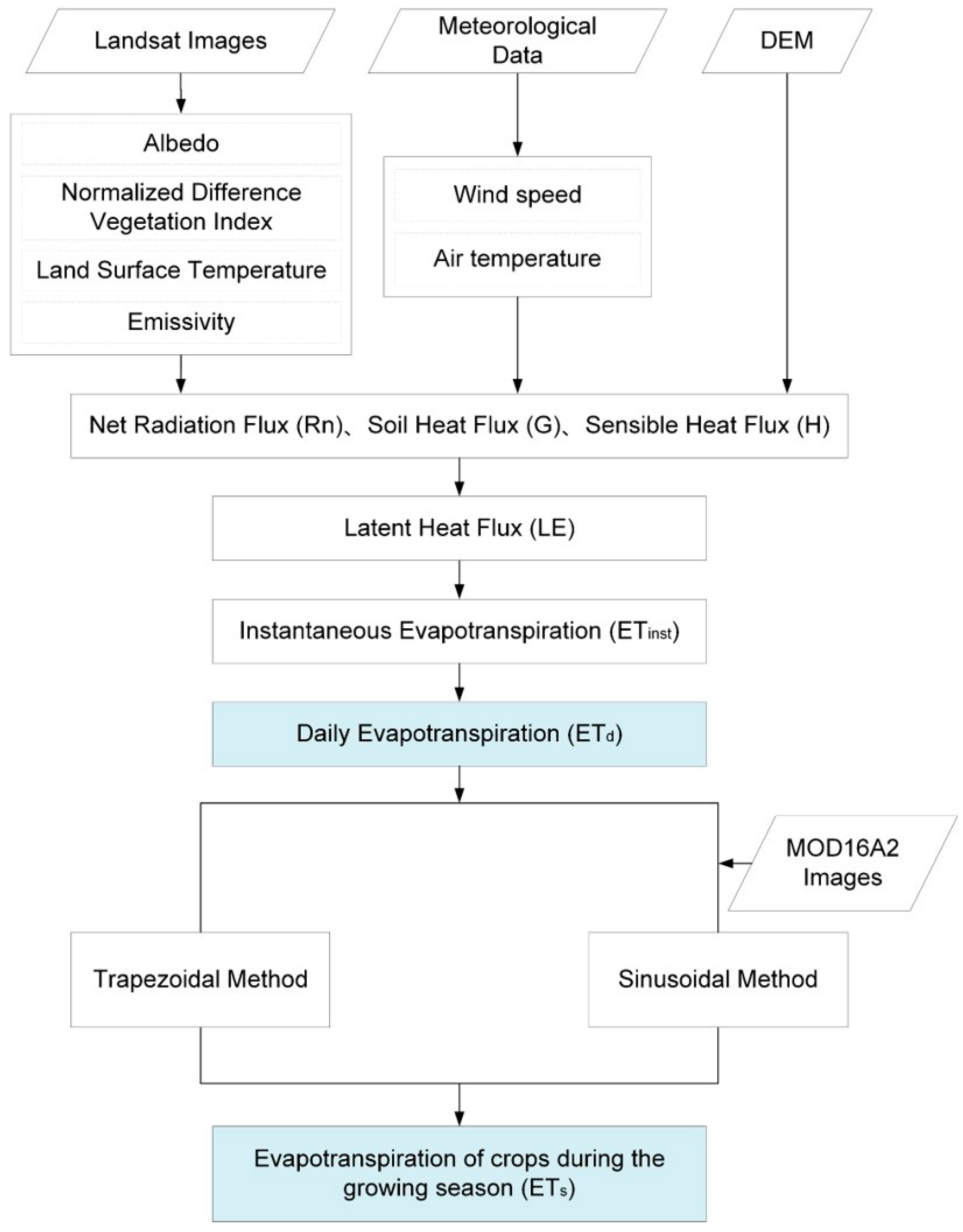
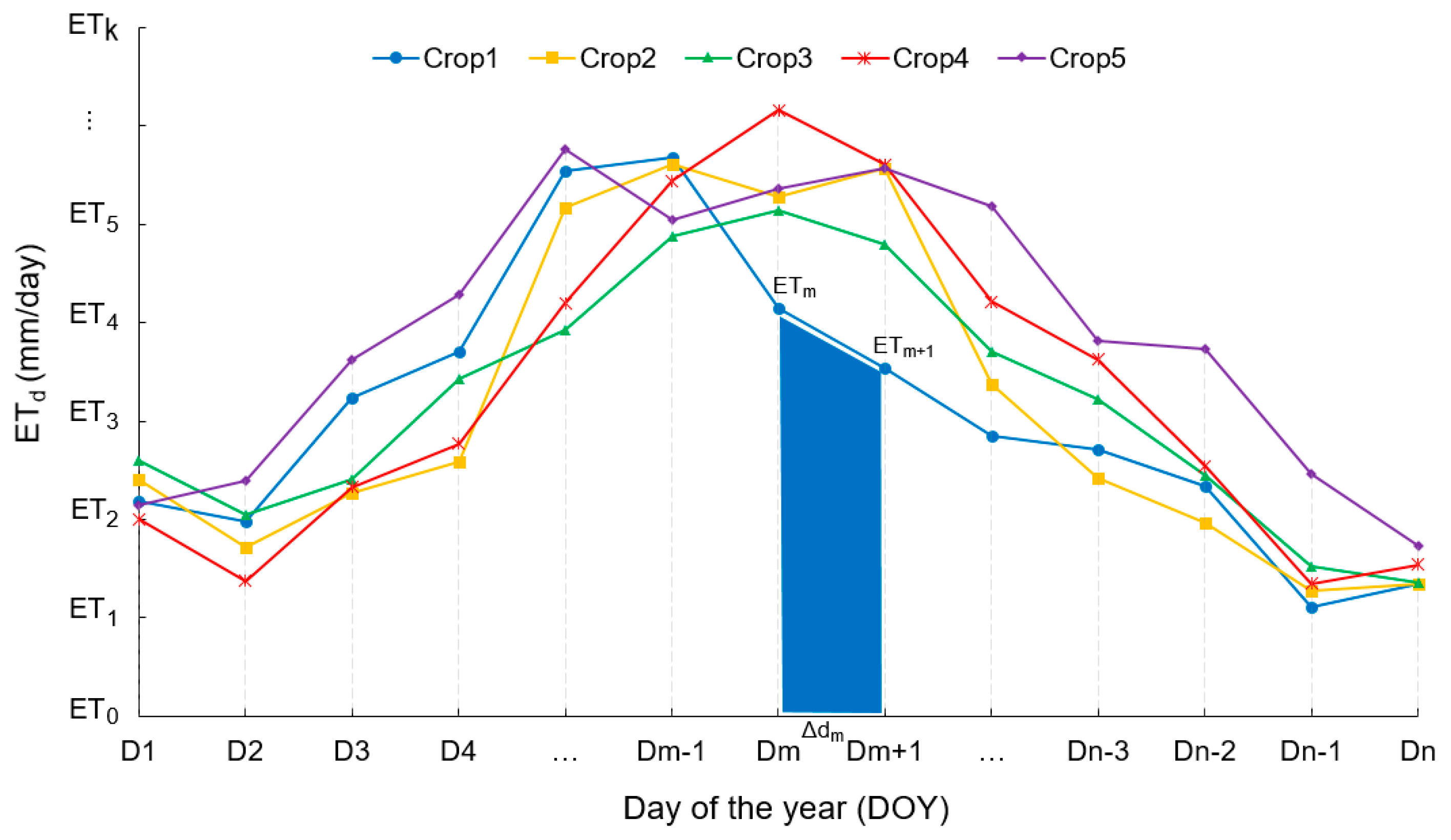
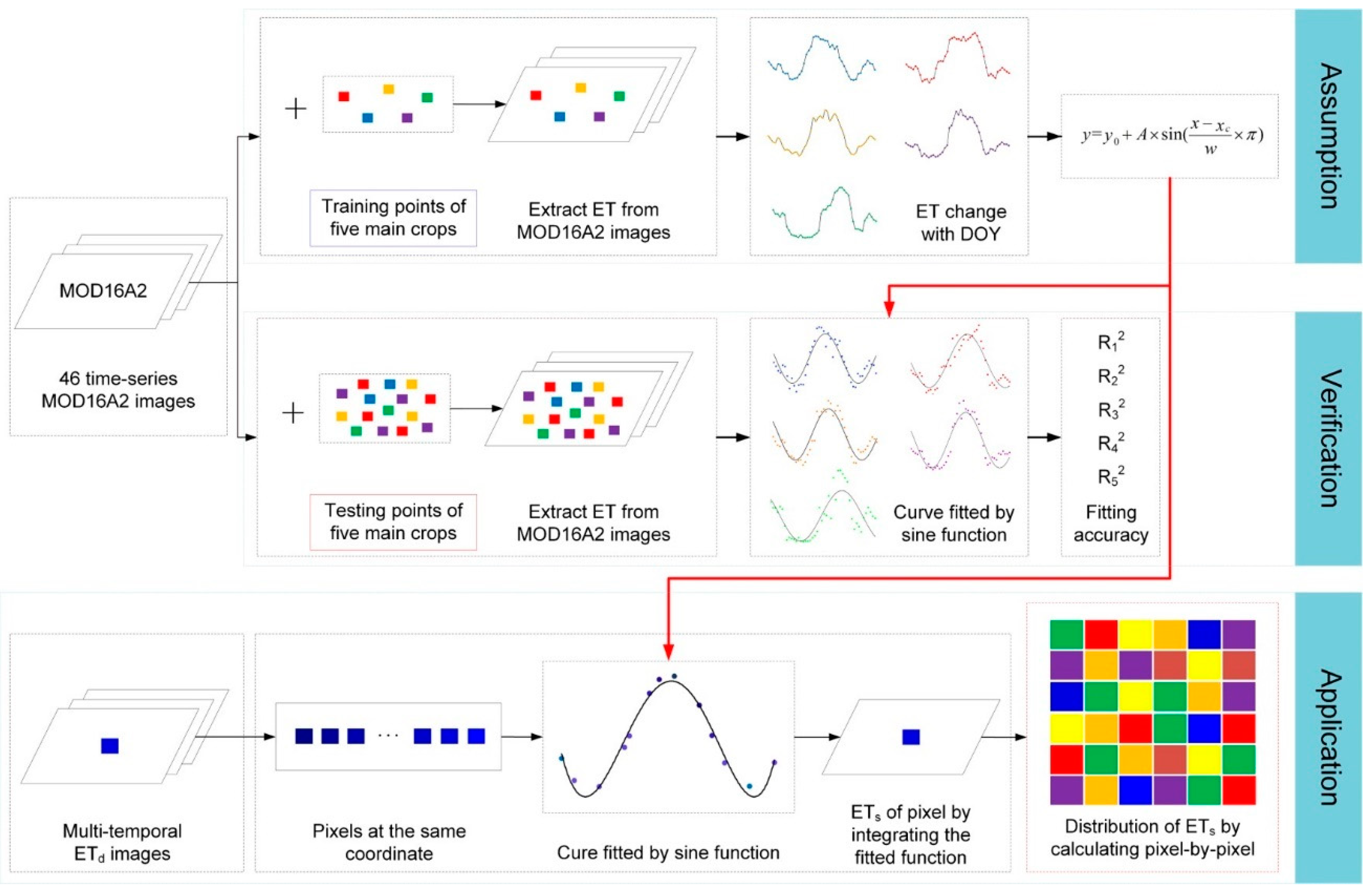
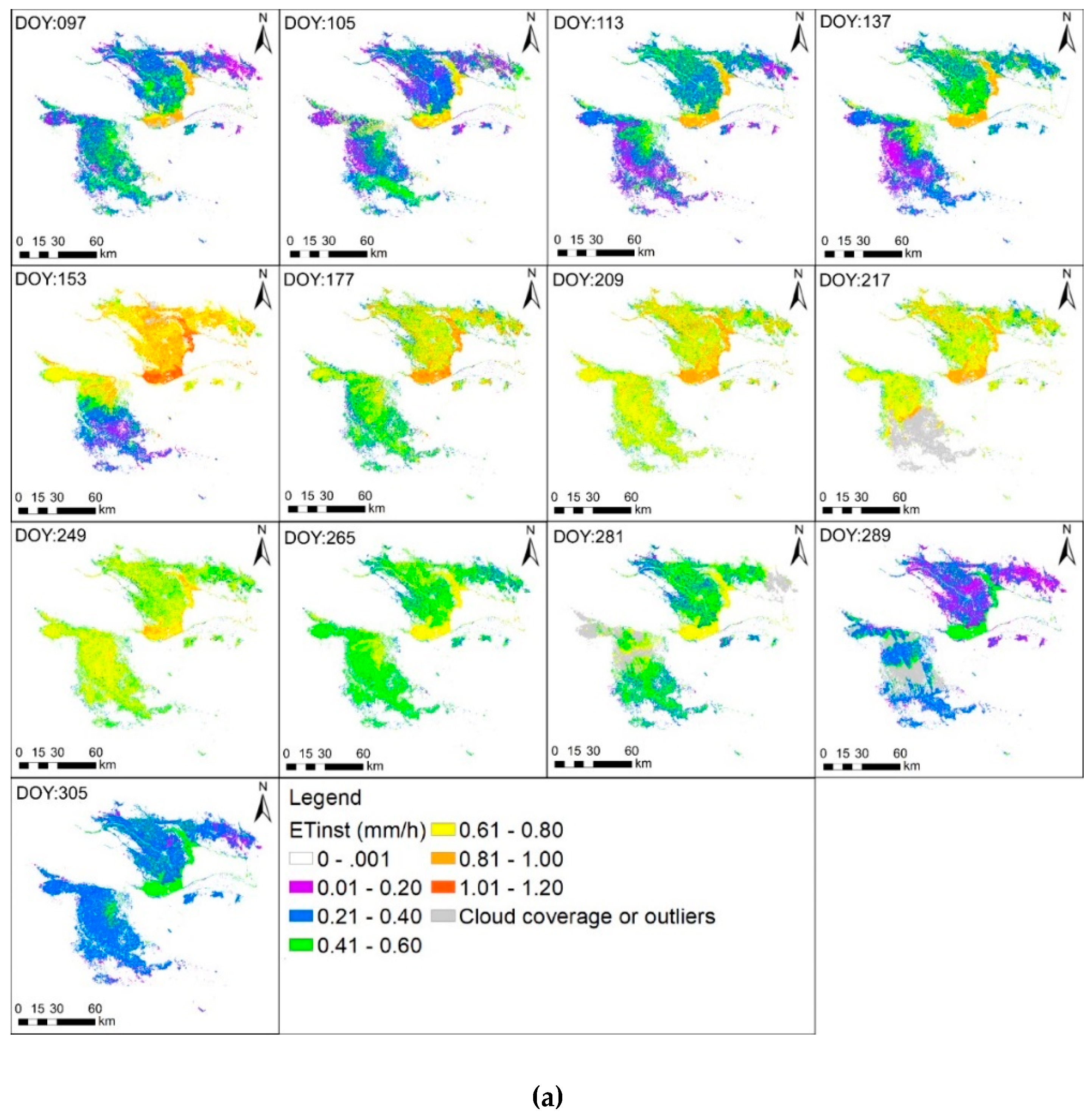
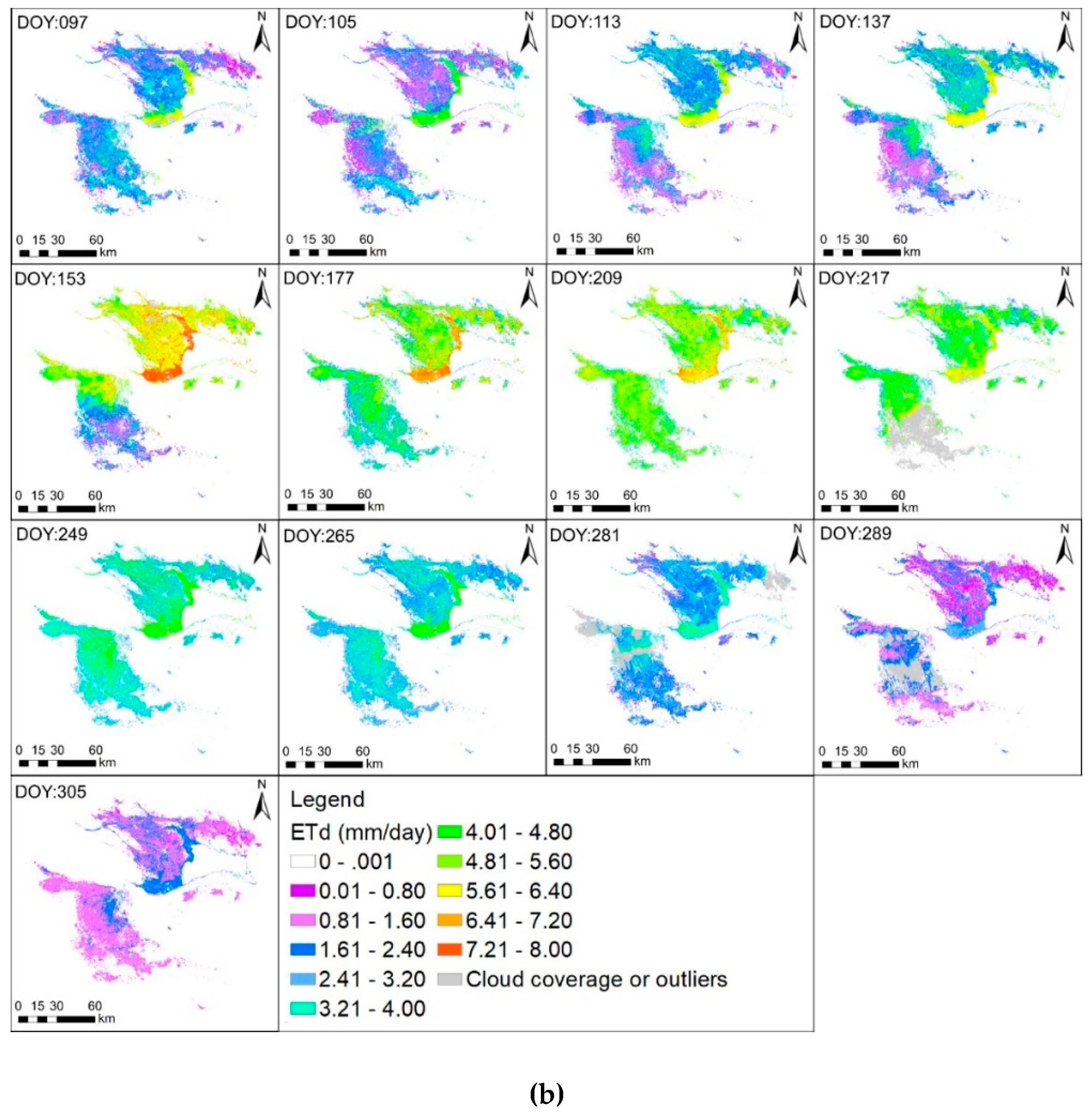
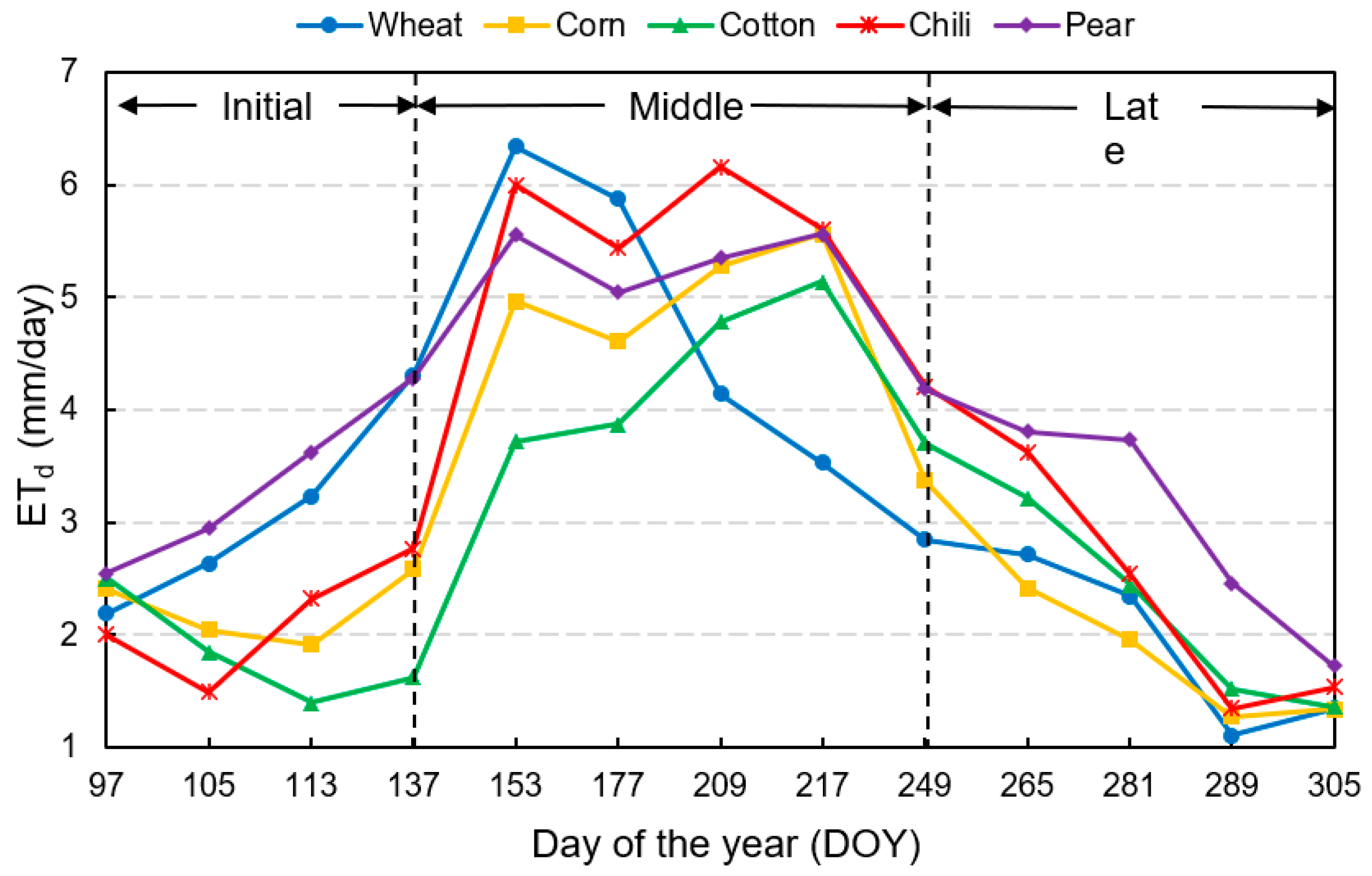
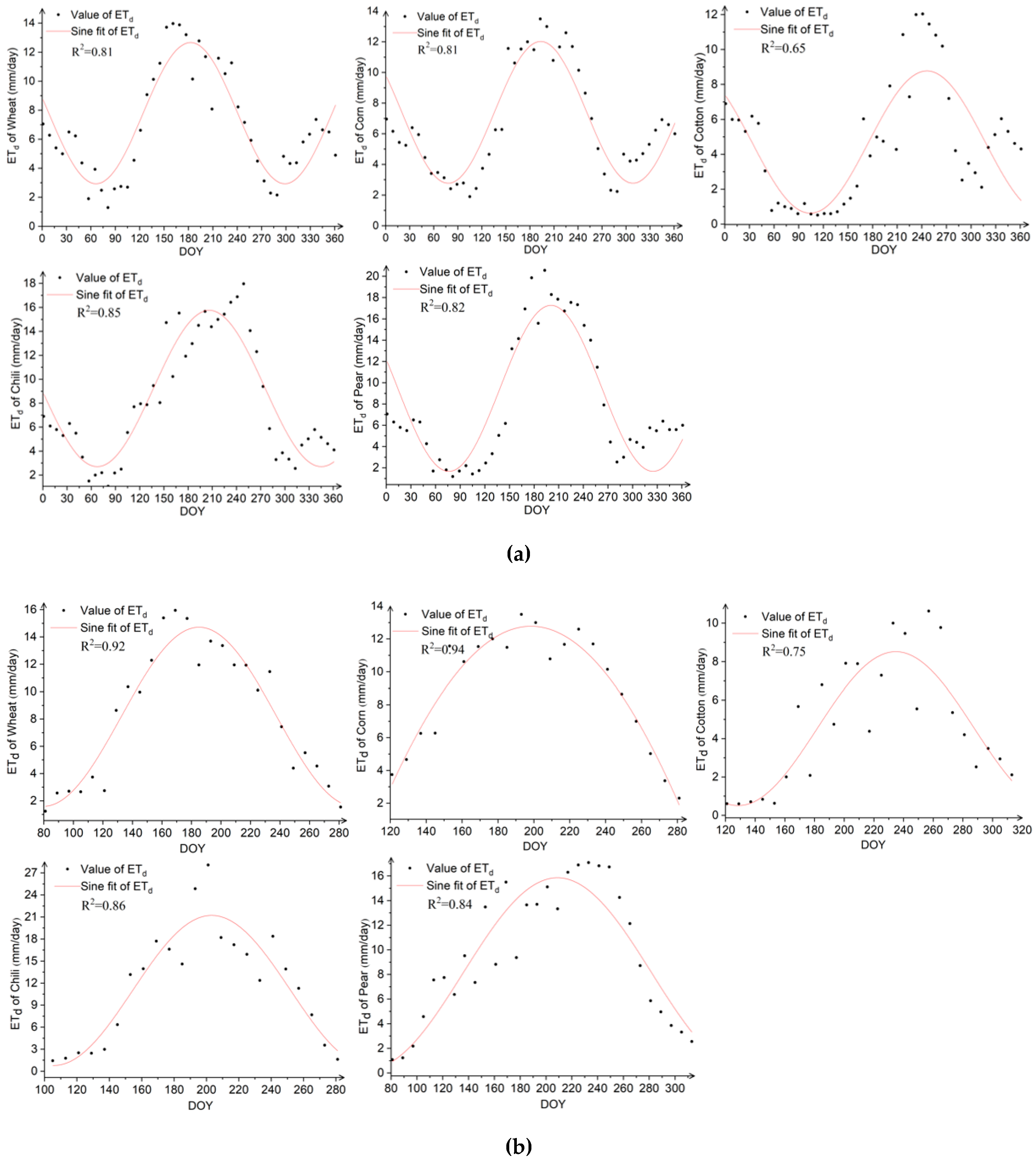



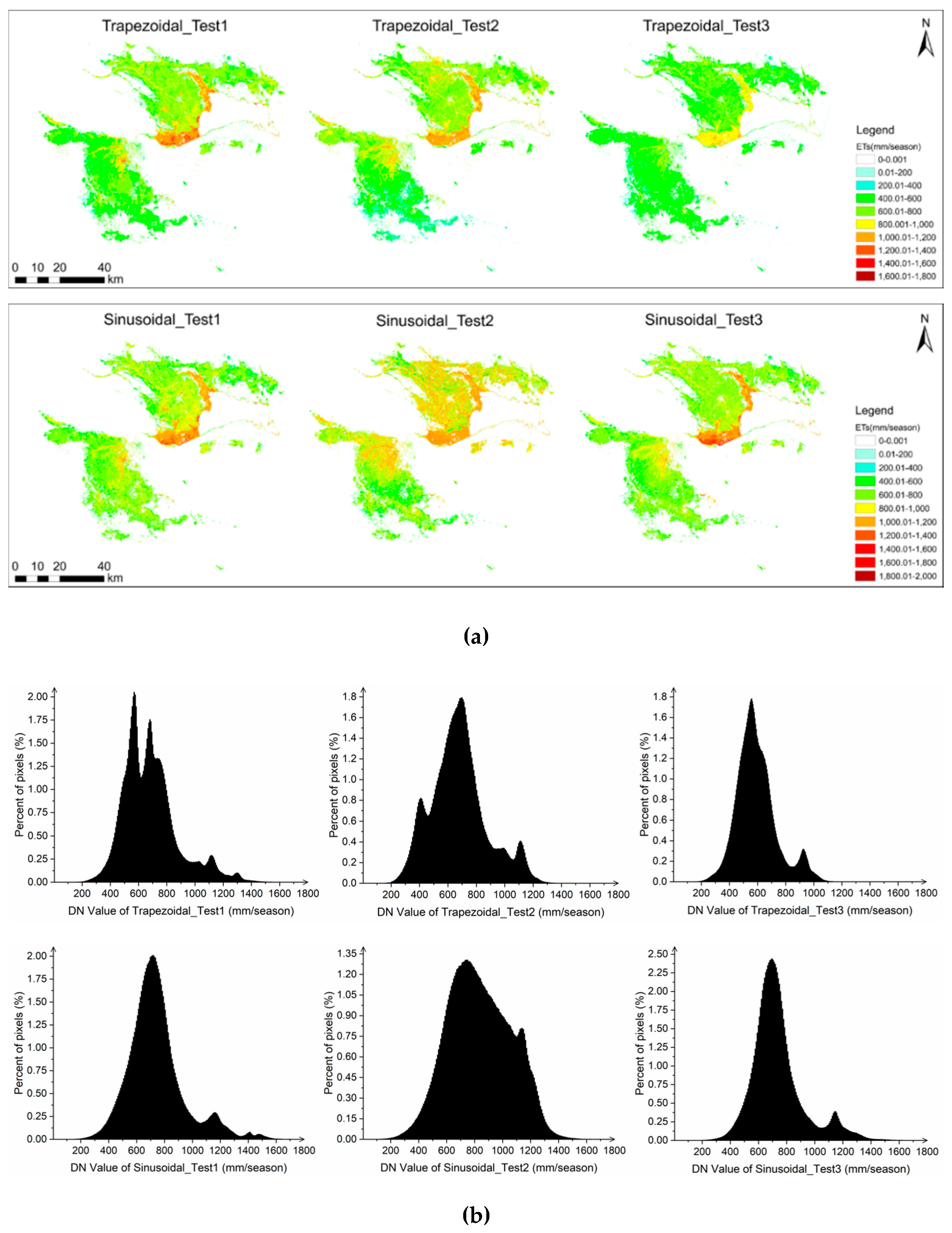
| Date | DOY | Satellite and Sensors |
|---|---|---|
| 6 April | 97 | Landsat 7 ETM+ |
| 14 April | 105 | Landsat-8 OLI/TIRS |
| 22 April | 113 | Landsat 7 ETM+ |
| 16 May | 137 | Landsat-8 OLI/TIRS |
| 1 June | 153 | Landsat-8 OLI/TIRS |
| 25 June | 177 | Landsat 7 ETM+ |
| 27 July | 209 | Landsat 7 ETM+ |
| 4 August | 217 | Landsat-8 OLI/TIRS |
| 5 September | 249 | Landsat-8 OLI/TIRS |
| 21 September | 265 | Landsat-8 OLI/TIRS |
| 7 October | 281 | Landsat-8 OLI/TIRS |
| 15 October | 289 | Landsat-8 OLI/TIRS |
| 31 October | 305 | Landsat-8 OLI/TIRS |
| Date | ETd (mm/day) | ET0 (mm/day) | Kc | ETc (mm/day) | Difference (mm/day) | Accuracy |
|---|---|---|---|---|---|---|
| 22 April | 1.28 | 4.38 | 0.26 | 1.14 | −0.14 | 0.88 |
| 27 July | 5.14 | 5.01 | 1.20 | 6.01 | 0.87 | 0.86 |
| 15 October | 1.52 | 2.46 | 0.70 | 1.72 | 0.20 | 0.88 |
| Crop Type | During the Interannual | During Crop Growing Season | ||
|---|---|---|---|---|
| Fitting Formula | R2 | Fitting Formula | R2 | |
| Wheat | 0.81 | 0.92 | ||
| Corn | 0.81 | 0.94 | ||
| Cotton | 0.65 | 0.75 | ||
| Chili | 0.85 | 0.86 | ||
| Pear | 0.82 | 0.84 | ||
| Crop Type | Average ETs (mm) | |||||
|---|---|---|---|---|---|---|
| a | b | c | a-b | a-c | c-b | |
| Wheat | 736.63 | 634.57 | 660.18 | 102.06 | 76.45 | 25.61 |
| Corn | 668.18 | 645.53 | 641.43 | 22.65 | 26.75 | −4.10 |
| Cotton | 725.18 | 638.52 | 690.61 | 86.66 | 34.57 | 52.09 |
| Chili | 800.33 | 753.29 | 755.08 | 47.04 | 45.25 | 1.79 |
| Pear | 956.37 | 891.00 | 943.81 | 65.37 | 12.56 | 52.81 |
| Test | Acquisition Date of Landsat Images (DOY) | ||||||||||||
|---|---|---|---|---|---|---|---|---|---|---|---|---|---|
| 97 | 105 | 113 | 137 | 153 | 177 | 209 | 217 | 249 | 265 | 281 | 289 | 305 | |
| 1 | √ | √ | √ | √ | √ | √ | √ | √ | √ | ||||
| 2 | √ | √ | √ | √ | √ | √ | √ | √ | √ | ||||
| 3 | √ | √ | √ | √ | √ | √ | √ | √ | √ | ||||
© 2020 by the authors. Licensee MDPI, Basel, Switzerland. This article is an open access article distributed under the terms and conditions of the Creative Commons Attribution (CC BY) license (http://creativecommons.org/licenses/by/4.0/).
Share and Cite
Cha, M.; Li, M.; Wang, X. Estimation of Seasonal Evapotranspiration for Crops in Arid Regions Using Multisource Remote Sensing Images. Remote Sens. 2020, 12, 2398. https://doi.org/10.3390/rs12152398
Cha M, Li M, Wang X. Estimation of Seasonal Evapotranspiration for Crops in Arid Regions Using Multisource Remote Sensing Images. Remote Sensing. 2020; 12(15):2398. https://doi.org/10.3390/rs12152398
Chicago/Turabian StyleCha, Mingxing, Mengmeng Li, and Xiaoqin Wang. 2020. "Estimation of Seasonal Evapotranspiration for Crops in Arid Regions Using Multisource Remote Sensing Images" Remote Sensing 12, no. 15: 2398. https://doi.org/10.3390/rs12152398







